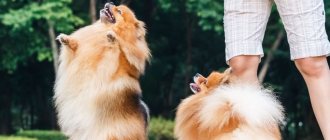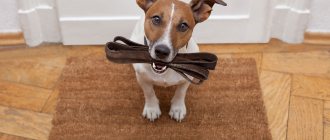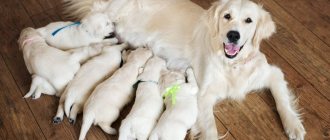Who is this course for?
The beginning of training for any service or sport dog begins with the initial training course. The requirements of the one who trains must be strict. The student is expected to strictly and accurately carry out each command.
There should be no connivance. In the process of studying the course, you can understand how trainable the dog is and identify its working qualities. The best representatives are selected for breeding, to pass on their training abilities to their descendants.
Only after passing what is included in the OKD for dogs, the pet is allowed to learn more complex skills, for example, those that are applicable in the ZKS (protective guard service).
Attention! When starting training, it is necessary to conduct it regularly. This is a mandatory condition of the OKD.
Ready for training
What is a ZKS for dogs?
Unlike UGS, OKD and ZKS for dogs are officially approved types of training required for animals participating in breeding. The basics of protective guard service were developed by domestic dog handlers. The skills acquired after completing the training were actively used among working breeds. Gradually, owners of completely ordinary pets became interested in them. PCL training in dogs is aimed at developing 3 instincts:
- protective, showing when protecting entrusted things and owners;
- social, necessary for adequate interaction with others;
- hunting, used to capture and escort intruders.
After passing the ZKS, animals can participate in search operations, guard prisoners and determine the location of drugs by smell. Despite this, most owners are limited to the skills of protecting the territory and people.
Why you should give your puppy for training
By giving the puppy to an experienced instructor for training, the owner hopes that his pet will quickly master the general course. He's right about that. It will not be difficult for a professional to teach an animal basic commands. To do this, he will need several days to establish contact with his ward, and a month to master the basic commands.
But the owner loses sight of the fact that by giving the pet into the wrong hands, he will not watch it grow up. But this is only one side of the coin. A dog trained by a trainer will not show the same results at a show with its owner, since it is accustomed to obeying another person.
It's even worse with hunting dogs. A well-trained hunting dog, with a diploma, obeys only a specific person. She may refuse to work with the owner. Only an experienced hunter can convince her.
Attention! Even when you give a dog to a trainer with maintenance and receive a well-trained dog back, you cannot be sure that it will obey its owner.
The dog is used to listening to the trainer. In order to achieve what you want, you need to do extra work with your pet at home in addition to classes at school.
Then there will be mutual understanding and obedience. If nothing has changed in the parent’s house, the ward is fed deliciously and nothing is demanded of him, then the training will return to the stage from which it began, to disobedience and bad habits. Training may only last for a short time.
Training in basic programs
OKD: training methods
Our center accepts all breeds for training, from puppies from 5-6 months who have completed training to adult dogs.
OKD develop certain skills and reflexes in the dog and establish a hierarchy. The general training course includes the development of basic commands, on which service and sports training is subsequently built:
- "to me";
- "near";
- "place";
- "ugh";
- maintaining the positions “sit”, “lie”, “stand”;
- submission to the trainer’s gesture, voice, sound signal, including at a distance;
- "fetch";
- overcoming obstacles on the site (boom, ladder).
At the owner's request, we can include additional commands and combine them with other courses.
The dog trainer describes what the skill looks like and what the dog should do, teaches how to influence it, analyzes the reaction to training, and corrects mistakes. Upon completion of training, your student passes the standards. Students who pass the general test receive a certificate.
You can train your pet in a group or undergo individual training with an instructor on site. At the same time, every owner must follow the rule - the skills acquired by the dog at school must be reinforced at home, during a walk, then the classes will give the desired result.
Sign up
Self-training a dog
A dog can only be ideal if it is raised by its owner. The main thing is to set yourself up not only to start learning, but also to bring it to the end, and not give up halfway. Before studying commands on your own, at home, you need to understand what training is and what is meant by education.
During the training process, the dog is taught commands such as “sit”, “lie down”, “come to me”. But weaning a dog from running after the neighbor's cats and not chewing the owner's furniture and slippers is part of education.
Important! The basic section of OKD is aimed, first of all, at teaching your pet obedience. It is difficult to communicate with an animal that does not know basic primitive commands.
OKD standard
GENERAL TRAINING COURSE (GTC) TESTS General provisions. Dogs of any breed are allowed to take part in the tests. The dogs are 12 months old (determined on the day of testing). OKD tests are carried out on a training ground with a natural surface, equipped with the necessary equipment: 1. Boom - height 1 m, board width 0.20 m (command “Forward”) 2. Blind fence 1.5 m (command “Barrier”) 3 Athletics hurdle - height 0.75 m (team "Hurdle") 4. Trench - gap 1.5 m (team "Forward") 5. Ladder. height 3 m. (command “Forward”) 6. Slide – height 1.6 m. (command “Barrier”) Projectiles are divided into three categories: * Transitional - boom and ladder * Supporting - barrier and slide * Unsupported - athletics barrier and trench Test subject with a dog can choose 3 projectiles - one projectile from each category. According to the general training course, the following are checked: 1. Display of the dental system, attitude towards the muzzle, transition to a free state on the command “Walk” 2. Attitude towards food (area with scattered food, in a 3x4 m square) and the prohibiting command “Fu”. — checked in one of 2 options: * on the stern held out on the handler’s hand. * on the retrieval item. 3. Apportation (object weight up to 500 grams) Command “Apport” 4. Return to place. Command “Place” 5. Approach to the trainer from a free state. Command “Come to me” 6. Stand, landing, laying (checked as a whole). 7. The movement of the dog next to the trainer. Team “Nearby” 8. Overcoming obstacles. 9. Controllability of the dog when shooting. Tests for dogs with a height at the withers of 42 cm and below are carried out according to these standards, taking into account changes in the size of obstacles and the distance for control. The height of such dogs is checked before the start of the tests. The trainer controls the dog in accordance with the commands established by these rules by voice and gesture. The trainer must give the command by voice and gesture immediately after the judge’s instructions. You are allowed to influence the dog's behavior for 3 seconds. The actions of the trainer during the tests are supervised by the judge.
Testing of projectiles is permitted. Before starting each skill, the trainer and the dog take the starting position (the dog sits parallel to the trainer’s left leg, without falling over). After completing the skill, petting the dog is allowed, as well as encouraging it with your voice. Rewarding with treats and playing with the dog between skills is not allowed. When summing up the final score for a skill (complex), the judge should distinguish between additional actions of the trainer that affect the work of the dog, and actions of the trainer that did not lead to changes in the work of the dog. All actions of the trainer that distort or supplement the normative command when demonstrating a skill (complex) and affecting the work of the dog are assessed as additional influences on the dog and are fined, each separately under the item “other violations” of this skill in the evaluation sheet. The trainer is not given a separate score, but at the end of the test the judge gives a qualitative assessment of the trainer’s work (excellent, good, satisfactory). For rough treatment of a dog, the trainer is removed from testing. Depending on the points awarded at the end of the test, a diploma of 1st, 2nd, 3rd degree is awarded. The overall score of the dog's performance is based on the total points scored in accordance with the final table of points scored, subject to the completion of each skill. The dog's performance is assessed by the judge for each skill or complex in accordance with the table of penalty points. For incorrect and unclear actions, penalty points are deducted from the highest score for a skill (complex). Tests begin with a report. The trainer with the dog approaches the judge and stops 2-3 meters from him, introduces himself and clearly reports his readiness for the test. When accepting tests, the behavioral characteristics characteristic of each breed are taken into account. Dogs that go beyond the trainer's control during testing are removed. The skills “Moving close” and “Approaching the handler” are assessed throughout the test.
Preparation for OKD
To receive an OKD diploma, you need to pass certification, which includes passing the standards of training disciplines. Here you need the help of a dog handler, since the exam consists of certain subtleties and nuances that affect the grading system, and not everyone knows about them.
Note! It is recommended to carry out training 2 times a day. The student is not fed before class. The lesson itself takes place over 2 hours. Testing is carried out no earlier than the puppy turns 1 year old.
Which dogs need a course?
ZKS courses are suitable for working dog breeds: shepherds, Dobermans, American bulldogs, Rottweilers, Russian terriers. Size matters less here than character. Central Asian and Caucasian Shepherd Dogs are poor at fetching objects, but they are very good at personal guarding the owner and his belongings. Particular attention is paid to the nervous system: individuals that are too aggressive and timid are not suitable for service.
Due to its peculiarities, PCL training in dogs is available only after completing a general course (OKD). A basic program aimed at raising the animal facilitates further training.
In addition to successfully passing the OCD, the future defender must be in good health, at least 60 cm tall and at least 1 year old. First of all, vision, hearing and smell are checked. The dog must be energetic and brave. Distrust of strangers is encouraged.
What is included in the general course
During the exam, the dog must show perfect command of the commands “stand”, “sit”, “lie down”, “fu”.
Besides:
- The judges evaluate the pet, how it behaves around its owner, how it approaches its owner on demand and returns to its place.
- The display of teeth, the dog’s relationship to the muzzle, and the execution of the “fetch” command are assessed.
- The pet must be able to overcome obstacles in the form of barriers, stairs, fences, and be able to climb an inclined wall.
The standards of the general course of the Russian Cynological Federation (RKF) also include the pet’s reaction to a shot.
Additional Information . Commands can go in any order, with the exception of those that are included in the complex diagram.
ACCORDING TO THE GENERAL TRAINING COURSE (OCD)
TESTS - General
OKD tests are carried out on a training ground with a natural surface, equipped with the necessary equipment: boom, blind fence, inclined wall in the shape of the letter “A”, l/a barrier, ladder. Dogs of any breed are allowed to take part in the tests. The age of the dogs is 12 months - determined on the day of testing.
According to the general training course, the following are checked:
- Demonstration of the dental system, attitude towards the muzzle, transition to a free state.
- Attitude towards food, prohibiting command “Fu”.
- Importation.
- Return to place.
- Approach to the trainer.
- Stand, landing, laying (checked as a whole).
- The movement of the dog next to the trainer.
- Overcoming obstacles.
- Controllability of the dog when shooting.
Tests for dogs with a height at the withers of 42 cm and below are carried out according to these standards, taking into account changes in the size of obstacles and the distance for control. The height of such dogs is checked before testing begins.
The trainer controls the dog in accordance with the commands established by these rules by voice and gesture.
The trainer must give the command by voice and gesture immediately after the judge’s instructions. You are allowed to influence the dog's behavior for 3 seconds. The actions of the trainer during the tests are supervised by the judge.
Testing of projectiles is permitted.
Before starting each skill, the trainer and the dog take the starting position (the dog sits parallel to the trainer’s left leg, without falling over).
After completing the skill, petting the dog is allowed, as well as encouraging it with your voice. Rewarding with treats and playing with the dog between skills is not allowed.
When summing up the final score for a skill (complex), the judge should distinguish between additional actions of the trainer that affect the work of the dog, and actions of the trainer that did not lead to changes in the work of the dog.
All actions of the trainer that distort or supplement the normative command when demonstrating a skill (complex) and affecting the work of the dog are assessed as additional influences on the dog and are fined, each separately under the item “other violations” of this skill in the evaluation sheet.
The trainer is not given a separate score, but at the end of the test the judge gives a qualitative assessment of the trainer’s work (excellent, good, satisfactory). For rough treatment of a dog, the trainer is removed from testing.
Depending on the points awarded at the end of the test, a diploma of 1st, 2nd, 3rd degree is awarded. The overall score of the dog's performance is based on the total points scored in accordance with the final table of points scored, subject to the completion of each skill.
The dog's performance is assessed by the judge for each skill or complex in accordance with the table of penalty points. For incorrect and unclear actions, penalty points are deducted from the highest score for a skill (complex).
Tests begin with a report. The trainer with the dog approaches the judge and stops 2-3 meters from him, introduces himself and clearly reports his readiness for the test.
When accepting tests, the behavioral characteristics characteristic of each breed are taken into account. Dogs that go beyond the trainer's control during testing are removed. The skills “Moving close” and “Approaching the handler” are assessed throughout the test.
Team "Place"
This skill means that a dog’s place can be any thing familiar to the animal.
- First, an object familiar to her is placed in front of the pet, indicating that this is her place.
- Then the trainer moves 15 meters away, calls the subject to him and commands “place”.
- The skill is counted if the diameter of the entrance to the starting position does not exceed 1 meter from the object.
The place can also be the owner’s backpack
Team "Aport"
Perhaps this skill is learned by a puppy more easily than others. It is perceived as a game. The examiner is thrown an object and, after a delay of 10 seconds, is ordered by gesture and voice to bring it.
The dog with the object must return to the trainer and sit at his left leg until the command “give” is heard, after which the object is given.
Attention! If you lose an item, play with it, or do not want to give it back, the skill is considered not completed.
Execute the command aport
List of trainable skills
When training, natural aggression is used. Because of this, it is not recommended to train yourself. Mistakes made can lead to excessive aggressiveness or cowardice in the dog, which poses a danger to others. All classes must be conducted under the guidance of an experienced dog handler.
Protection of things and the owner
This skill is indispensable if you don’t have a storage room. In the future, you can entrust your pet with valuable luggage and even a stroller with a child, calmly going to the nearest store for shopping.
Training begins with guarding a small thing. In the future, the skill can be developed up to the protection of a large building and even a secret facility.
Training is structured as follows:
- The owner gives the pet the command “sit” or “lie down”.
- After taking the desired pose, the dog is given an item and commanded “guard.” Immediately after this, the owner leaves the animal's field of view.
- An instructor appears on the site, trying to take away a trusted item. He uses a bait with food, flicks the dog on the nose and lightly hits him on the sides with a twig.
- The subject must show aggression only when attempting to attack a protected item. Strangers on the site passing by should not bother him.
The training program simulates real life situations. As a result, the four-legged pet guards the entrusted object without harm to others.
Item selection
This skill develops the sense of smell, helping to identify objects with the same smell. A developed sense of smell is indispensable when searching for missing people, criminals or dangerous goods.
At the beginning of the test, the dog is introduced to the object using the “sniff” command. Next, he is asked to find another object with an identical smell using the “search” command. The sampling site must be 3 m away from the animal. The pet must smell the correct piece of cloth or piece of wood, choosing from the 5 proposed options, and bring it to the owner.
Detention and escort of the violator
One of the most dangerous trainings involving the capture of a person. Helps to practice the skill of protecting a home in the event of a robbery or family members in the event of a direct attack by an intruder.
Training is divided into 4 stages:
- Detention
. The pet follows the owner on the command “near” or simply sits at his left leg. A trainer dressed in a protective suit suddenly appears and attracts the dog's attention with threatening gestures using a whip. After the word “fas,” the animal takes off and grabs the intruder with a death grip. The trainer commands “fu” and approaches the caught one. - Escort with assassination attempt
. Together with the dog, the owner escorts the intruder, moving behind his back. The pet, having received the “guard” signal, carefully monitors the escort. After 10 steps, the criminal attacks the trainer. An attempt to attack is stopped by the dog without receiving commands. The grip loosens after the starting pistol fires and the word “ugh”. - Search
. The dog carries out the command “sit” or “guard”, supervising the search of the offender and the removal of the whip. - Escort to the police station
. The further hike continues from the side. The trainer commands “near” or “guard”, and at the end of the path he stops the pet with the command “sit”.
In addition to direct capture, the animal helps to disarm, detain or deliver a criminal directly into the hands of law enforcement agencies. Remember that learning on your own may result in injury or inappropriate behavior.
Overcoming a set of obstacles
Overcoming obstacles can be in any order. Commanding, the owner pushes over the obstacle, calls the dog to him, and together they go to the next barrier. At the same time, helping the pet on the part of the owner is fraught with the accrual of penalty points.
The OKD diploma is three-level. It all depends on the number of points scored:
- 1st level 90-100 points;
- 2nd stage - 80-89 points;
- Level 3 - 60-79 points.
Obstacles are overcome without touching the crossbar with your paws
Accessories required for passing
When practicing initial training skills, you need: 2 leashes, a long one up to 2 meters and a short one, a collar or harness, a muzzle. It is also good to have a bag with a treat for reward, a toy for fetch, and a rug that will determine the place.
You need to start OKD classes from the first days your pet arrives in the house. Obedience skills are necessary for dogs of all breeds, small and large. What degree of difficulty to choose is up to each individual to decide. But in order to be included in the list of dogs eligible to serve in law enforcement agencies, having an OKD diploma is mandatory.











